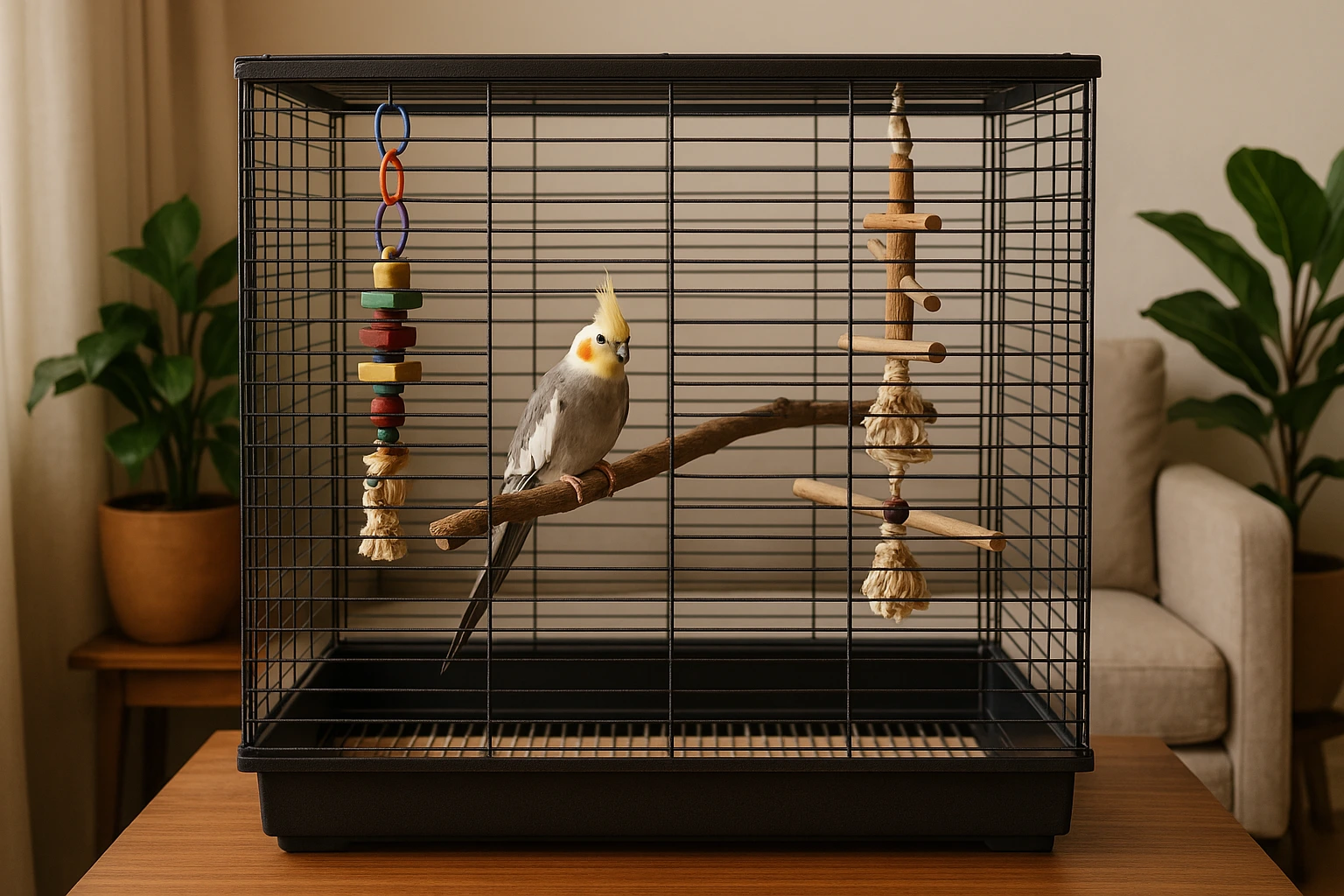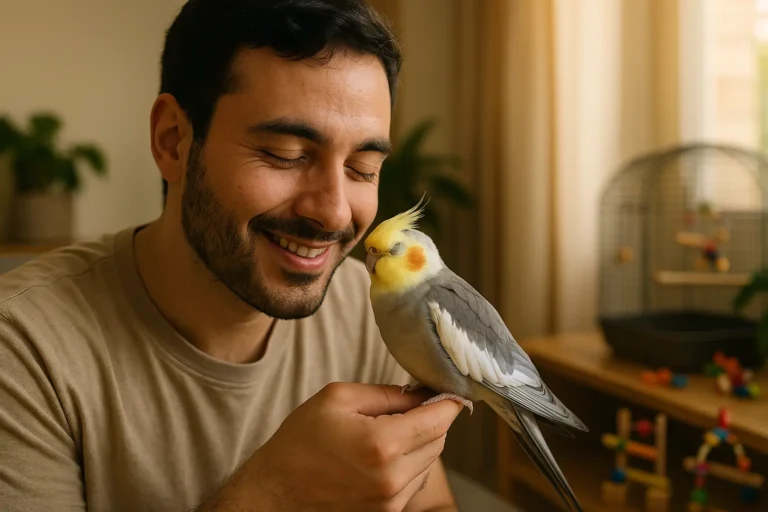Best Cockatiel Cage Setup: How Big Should It Really Be?
Cockatiels are not only intelligent and playful birds but also incredibly active. As a long-time breeder, I saw how much space and stimulation they need to stay happy and healthy. One of the most important things you can do for your cockatiel is give them the right cage setup. In this post, I will share everything I learned about the Best Cockatiel Cage Setup from ideal sizes and safety to accessories and common mistakes. This guide will help you give your feathered friend a safe, comfortable, and engaging home.
Why Cage Size Matters for Cockatiels
Natural Behavior and Daily Activity in the Best Cage Setup
Cockatiels are highly active birds. They love to climb, flap their wings, and explore their surroundings. A cramped cage simply doesn’t allow them to express these natural behaviors. I saw birds become frustrated and even depressed when they don’t have enough space to move freely. A big cage lets your bird stretch its wings, hop between perches, and play with toys.
Impact on Mental and Physical Health
Lack of space can lead to serious problems. Birds in small cages often suffer from stress, leading to behaviors like screaming or feather plucking. Physically, they’re at risk of obesity and muscle loss due to lack of exercise. When you invest in the Best Cockatiel Cage Setup, you’re also investing in your bird’s mental and physical well-being. A spacious environment encourages movement, which keeps their body strong and their mind sharp.
What Is the Best Cockatiel Cage Setup?
Recommended Minimum Cage Dimensions
When choosing a cage, size truly matters. For a single cockatiel, I recommend a minimum of 24 inches wide, 18 inches deep, and 24 inches high (61 x 46 x 61 cm). If you’re housing a pair, go even bigger at least 30 inches wide, 20 inches deep, and 30 inches high (76 x 51 x 76 cm). Always go for width over height since cockatiels fly horizontally.
Bar Spacing and Safety Considerations
Safety is key. The bar spacing should be no more than ½ inch (1.27 cm) to prevent your bird from getting stuck or escaping. Wide bars can be dangerous, especially for young or curious birds. Stick with cages specifically designed for small parrots like cockatiels, and check for sharp edges or gaps that could cause injury.
Key Features of the Best Cockatiel Cage Setup
Horizontal Bars for Climbing
Cockatiels love to climb, and horizontal bars allow them to do just that. These bars help mimic natural movement and keep their legs and feet active. I always recommend cages with horizontal bars on at least two sides. You will see your bird enjoy climbing up, down, and sideways it’s great exercise and entertainment.
Easy-Access Doors and Feeding Stations
Cleaning and feeding should be easy, not a daily struggle. Look for cages with wide, easy-to-open doors and external food/water access. I personally love cages that let me refill dishes without reaching inside and disturbing the bird. It’s a small detail, but it makes a big difference.
Removable Trays and Grates
Good hygiene keeps birds healthy. A removable tray and grate system makes daily cleanup fast and effective. Just slide out the tray, replace the liner, and you’re done. This helps control odor and bacteria. I also recommend placing a sheet of newspaper or cage liner on the tray to simplify cleaning.
Cage Placement and Environment
Best Location in Your Home
Where you place the cage is just as important as what’s inside it. Cockatiels need to feel part of the family, but they also need quiet time. Avoid kitchens (fumes and smoke are dangerous), drafty windows, or isolated rooms. Place the cage in a well-lit, low-traffic area where your bird can interact with you but still rest peacefully.
Light, Temperature, and Daily Routine
Cockatiels love natural rhythms. Keep them in a room with natural light and establish a daily routine. I make sure my birds get 10–12 hours of sleep by covering their cages at night. Stable temperatures (65–80°F or 18–27°C) are best, and sudden temperature changes can cause illness.
Must-Have Accessories in the Best Cockatiel Cage Setup
Variety of Perches
Perches are not just for standing they’re for foot health too. Use natural wood perches of various thicknesses to give your bird’s feet a workout. Avoid sandpaper-covered perches, which can cause sores. I like to include at least three types: a natural branch, a rope perch, and a smooth wooden dowel.
Engaging Toys for Mental joy
Cockatiels are smart and need mental exercise. Bored birds often develop bad habits, so rotate safe toys weekly. I use foraging toys, mirrors, bells, and shred able items. Just make sure toys are bird-safe no small parts or toxic materials.
Food and Water Dishes in the Best Cage Setup
I always use stainless steel or ceramic dishes since they’re easy to clean and don’t absorb bacteria. Clip them at a height that’s easy for your bird to reach without sitting directly over them. Keep food and water in separate spots and change water daily.
Common Mistakes to Avoid When Setting Up a Cage
Many new owners unknowingly make mistakes. One common issue is choosing a cage that’s too tall and narrow. Cockatiels need width to fly side to side, not height to climb up and down. Another mistake is overcrowding the cage with too many toys or accessories, leaving no room to move. Also, don’t forget ventilation good airflow helps keep the cage fresh and your bird comfortable. Lastly, always clean the cage regularly. A dirty cage can lead to infections and respiratory problems.
Final Thoughts on the Best Cockatiel Cage Setup
Giving your cockatiel the best home starts with the right cage. A spacious, safe, and clean setup supports their natural behavior, health, and happiness. Make sure your cage has enough room to stretch, climb, and play, with thoughtful accessories like safe perches, toys, and easy-to-clean trays. Take a look at your current setup and ask yourself does it meet your bird’s needs? If not, a few simple changes could greatly improve their quality of life. A well-set-up cage not only makes your cockatiel feel at home but also builds a deeper bond between you and your cockatiel.



